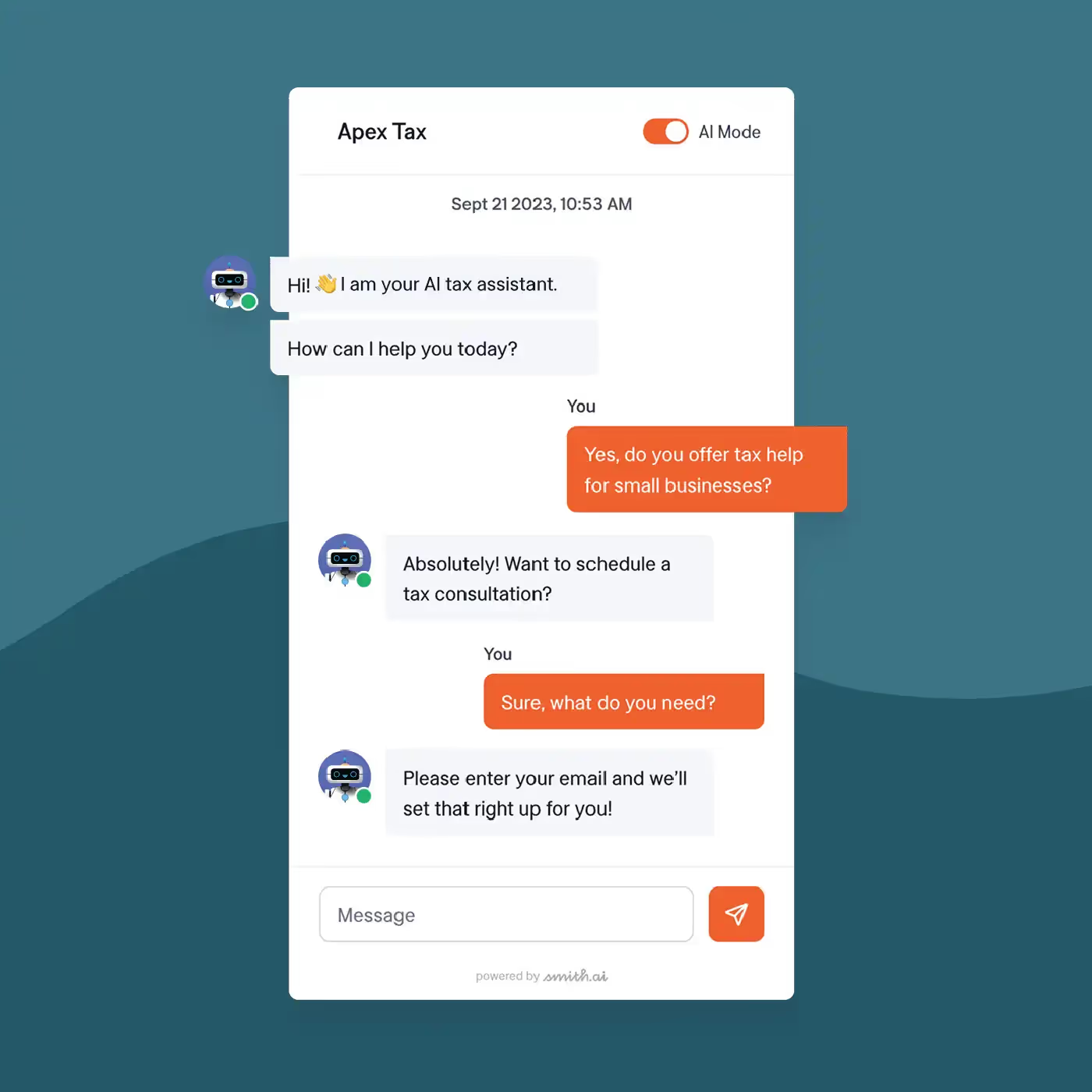How to Automate Call Answering and Appointment Booking
How to Automate Call Answering and Appointment Booking

Response time is critical in the competitive market. For a growing practice or small business, each unanswered ring or neglected web form represents revenue silently leaking from your pipeline. Manual follow-up can't keep pace with prospects who expect instant answers across calls, chats, texts, and forms.
End-to-end lead automation addresses this issue by integrating multi-channel intake, AI-driven qualification, personalized follow-ups, and real-time analytics. You transform a reactive scramble into a predictable revenue engine.
This approach requires four key steps: setting up multi-channel lead capture systems, implementing intelligent qualification and routing, configuring automated follow-up sequences, and continuously optimizing performance.
Follow this framework and you'll reclaim billable time, respond faster than competitors, and convert more inquiries into booked business without adding headcount.
1. Set Up Multi-Channel Lead Capture Systems
Every inquiry represents potential business, but leads arrive through multiple channels—phone calls, web forms, live chat, texts, and social media. Siloed channels cause data loss and slower responses.
Start with a 24/7 AI Receptionist from Smith.ai that transcribes calls, pushes contact details to your CRM, and captures intent through qualifying questions. Implement website forms that map directly to CRM fields and trigger real-time API calls, eliminating manual data entry errors.
Add chat and text widgets that feed the same pipeline.
Low-code tools can route messages through unified webhooks, allowing seamless cross-channel conversations. The AI Receptionist can continue chat conversations after hours and schedule appointments.
Maintain consistency with a universal field set (name, contact method, source, interest, timestamp) across all capture tools to enable accurate attribution analysis. Advanced automation platforms can automatically tag leads with UTM parameters for comprehensive tracking and analysis.
2. Implement Intelligent Lead Qualification & Routing
While prompt lead response is crucial for business success, effective qualification systems are equally important. Start with a clear framework that combines traditional criteria, such as BANT, with behavioral data from site visits, email engagement, and call transcripts to create real-time lead scores.
Configure the Smith.ai AI Receptionist with your qualification criteria (industry, location, budget, urgency) to automatically tag qualified leads and trigger immediate hand-offs through transfers, calendar bookings, or enriched CRM records. Build efficient routing rules using round-robin assignments for balanced workloads or territory/specialty routing for expertise matching.
Low-code platforms simplify rule creation, while industry-specific solutions, such as Lead Docket, offer specialized AI classification for legal intake. Ensure seamless CRM integration with two-way sync capabilities. Whether using Salesforce or specialized platforms like Ringy, automate logging for all interactions to update lead scores and trigger appropriate next steps. Conduct periodic reviews to adjust thresholds and continuously improve conversion rates.
3. Configure Automated Follow-Up Sequences
When business goes to the first responder, every delayed lead represents lost revenue. Automated follow-up sequences launch perfectly timed, multi-channel conversations immediately upon CRM entry.
The Smith.ai AI Receptionist handles call management and integrates with various automation tools, while platforms like Ringy enable channel swapping without custom coding. Smart appointment scheduling automatically books meetings when leads qualify, sending reminders and preventing double-booking through two-way calendar sync.
For sales teams, automate workflow progression with CRM-triggered tasks, script surfacing, and notifications. Legal tools, such as Lead Docket, attach intake summaries and retainer links for immediate action by attorneys.
Timing is crucial: the first contact should occur within five minutes, the second contact within 24 hours, and then spaced communications should be maintained over 10-14 days. Research shows that companies are 21 times more likely to qualify leads when they respond within 5 minutes versus 30 minutes.
4. Monitor, Measure, and Optimize Performance
Your lead automation system requires rigorous tracking and monitoring. Focus on four core metrics: volume (quantity), quality (lead score/SQL rate), speed (response time), and value (conversion/cost per acquisition). Real-time dashboards in platforms like Ringy and Lead Docket enable immediate trend spotting.
Integrate all touchpoints, calls, forms, chats, into a unified reporting view through your CRM's customizable dashboards. Track captured-to-accepted lead ratios and adjust routing rules when response times lag.
Implement systematic A/B testing (subject lines, SMS timing, appointment reminders) with automatic promotion of winning variants. Reference industry benchmarks when sequences underperform.
Watch for capacity issues, such as delayed task creation or booking queues, which indicate the need for more staff or tighter qualification standards. Over 52% of salespeople still find BANT reliable for qualifying prospects, with 41% valuing its flexibility.
Conduct quarterly audits to refresh scoring models and dashboards. Consistent optimization prevents small inefficiencies from impacting revenue.
Understanding Automation Fundamentals
Lead automation technologies vary in sophistication and capability, determining how effectively your business can capture and process inquiries. Understanding these fundamental differences enables you to build a system that strikes a balance between efficiency and personalization.
- Simplified Workflows: Basic rule-based automation follows fixed pathways: "If web form is submitted, create contact." It's dependable but blind to nuance and context.
- Intelligent Processing: AI-powered systems interpret language, detect sentiment, and enrich records with external data. They don't just file a lead; they tell you whether that lead looks like last month's high-value client.
- Enhanced Infrastructure: Core building blocks remain consistent, intake, enrichment, routing—but AI adds context at each step. An email parser backed by machine learning can extract a prospect's company size and push a preliminary score into your CRM before a salesperson lifts a finger.
- Personal Connection: Hybrid human-AI models, such as the Smith.ai approach, integrate human receptionists with AI technology. You keep the warmth of a live greeting while the back-end handles the grunt work, countering the misconception that automation equals impersonal.
- Performance Tracking: Regular attribution audits are essential; pull monthly reports showing leads per channel, qualification rate, and booked appointments. When discrepancies appear (like chat leads missing campaign tags), you can quickly tighten processes before revenue is affected.
Choosing the Right Tools and Integration Partners
Selecting the ideal automation tools centers less on feature lists and more on seamless integration with your existing technology stack. The most effective approach focuses on connectivity and workflow enhancement rather than collecting disconnected solutions.
- Start with your core systems: Begin with platforms you can't replace, such as your CRM, calendar, and billing software, and then work backward to identify compatible tools.
- Prioritize bi-directional data flow: CRMs designed for service businesses typically offer native integrations that reduce implementation time and effort. Confirm your chosen platform supports two-way data exchange to eliminate blind spots.
- Verify calendar compatibility: Instant meeting links from the Smith.ai AI Receptionist become worthless if your calendar system can't properly reserve the slot. While most modern platforms integrate with Google or Outlook, ensure that lead details transfer completely with each booking.
- Leverage the extensive Smith.ai integration network: The AI Receptionist connects to more than 5,000 apps through direct APIs and middleware, allowing you to avoid redundant solutions. If your CRM already handles drip emails, skip separate nurture tools and configure webhooks to trigger sequences automatically.
- Apply the three-criteria test: Evaluate potential tools by asking, 'Will it capture or enhance data you don't already have?' Can it act on that data without manual intervention? Does it integrate cleanly with the Smith.ai AI Receptionist and your core systems?
Tools that satisfy all three criteria should be considered for your tech stack. When your systems align properly, qualification processes run efficiently in the background, freeing you to focus on closing deals rather than managing busywork.
Your Action Plan
You now have a four-step blueprint: capture every lead across channels, qualify and route with intelligence, automate personalized follow-ups, and continually optimize with data. Execute this framework with these priorities:
Map your current lead sources and connect them to your CRM. Define scoring and routing rules that mirror your ideal client profile. Build multi-channel nurture sequences that keep leads warm without manual effort. Create a dashboard to track response time, conversion rate, and ROI. Activate the AI Receptionist from Smith.ai to handle first contact and sync data into your stack.
Businesses that respond first are significantly more likely to win deals, with some industry sources suggesting that up to 78% of B2B customers purchase from the vendor that responds first, although exact figures may vary.
A quick setup call with Smith.ai locks in that advantage and frees your team to focus on the work only humans can do. Schedule a consultation to get started.
Take the faster path to growth. Get Smith.ai today.
Key Areas to Explore
Technical Implementation Terms
Voice user interface (VUl) design
Speech recognition integration
Text-to-speech optimization
API connectivity and webhooks
Real-time data synchronization

Your submission has been received!














.svg)



